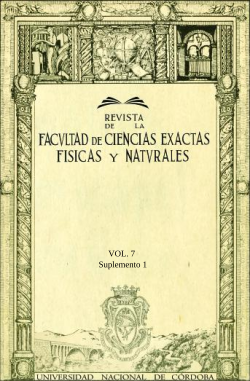Louis Agassiz en Chile y Argentina: Una historia poco conocida
Keywords:
Glaciers, Erratic boulders, Fossil fish, Catastrophism, Creationism.Abstract
Louis Agassiz (1807-1873) was a famous and influential Swiss geologist and paleontologist, who studied medicine in Heidelberg and Munich. During this time, his study on fishes interested Georges Cuvier, who invited him to Paris to study his own fish collection. Herewith, he acquired a catastrophist and creationist perspective on the development of life, as opposed to the evolutionary theory of Darwin (Juárez Barrera et al., 2016). He then worked at the University of Genève, in Switzerland, from where he acquired world-wide reputation with his books on glaciers in 1840 and 1847, in which he interpreted the presence of erratic boulders in the pre-alpine lowlands as transported by glaciers that in the geological past were more extended than at present. He even visualized the Earth fully covered by ice, a snowball earth condition, which was reconsidered during the last part of the XX century. In 1846, he moved to Harvard as zoology and geology professor, and he became one of the main scientific personalities of the US, by his qualities as a researcher, and mainly, as a communicator of science. He participated in the creation of the Academy of Sciences and of the Compared Anatomy Museum at Harvard. He was the last great scientist who denied Darwin´s theory of evolution, and held firmly to the catastrophist / creationist perspective, which led him into considerations about human races that brought him discredit.
Downloads
References
[1] Agassiz L. (1833-1842), “Monographie des poissons fossiles du Vieux Grès Rouge ou Système Dévonien (Old Red Sandstone) des Îles Britanniques et de Russie”, Paris. http://gallica.bnf.fr/ark:/ 12148/bpt6k972529/f1.table.
[2] Agassiz L. (1840), “Études sur les glaciers”. Ed. Del autor, Neuchâtel, 346 pp. + Atlas (18 láminas). [Reed. en: Dawsons of Pall Mall, Londres (1966). Existen algunos extractos en versión inglesa en: Mather y Mason (1939, pp. 329–335), y trad. inglesa en Carozzi (1967).
[3] Agassiz L. (1840), “Études sur les glaciers”. Jent et Gassmann, 346 p., Neuchâtel, Suiza.
[4] Agassiz L. (1847), “Nouvelles études et éxperiences sur les glaciers actuels, leur structure, leur progression et leur action physique sur le sol”. Victor Masson, Paris, 598 p.
[5] Hooker J. (2017), “Theorizing Race in the Americas: Douglass, Sarmiento, Du Bois, and Vasconcelos”. Oxford University Press, New York, 281 p.
[6] Juárez Barrera F., Bueno-Hernández A. y Llorente Bousquets J. (2016), “El creacionismo de Louis Agassiz y sus concepciones biogeográficas”. Academia Colombiana de Ciencias Exactas, Físicas y Naturales, Colección Luis Duque Gómez, Bogotá, Colombia,. N°4, 143 p.
[7] Kaeser M.-A. (2007), “Un savant séducteur. Louis Agassiz (1807-1873), prophète de la science”. L’Aire, Vevey, Suiza, 292 p.,
[8] Reggini, H. C. (1999), Presencia de Sarmiento en Boston. Revista Historia, Año XIX, Nº 75, sept./nov. 1999, Buenos Aires. http://horacioreggini.com.ar/wp-content/uploads/2013/10/ Sarmiento-Boston-2.pdf
[9] Reggini H. C. (2014), Dos décadas de amistad epistolar (1865-1881) entre Mary Peabody Mann y Domingo Faustino Sarmiento. http://horacioreggini.com.ar/wp-content/uploads/2014/03/ Dosdecadas....
[10] Ryn Z. J. (2014), “Ignacio Domeyko. La Vida y la Obra”. Editorial Universitaria: 937 páginas, Santiago, Chile.
[11] Sequeiros L. y García Cruz C. (2006), “Louis Agassiz (1807-1873) y sus aportaciones a la geología. Implicaciones didácticas”. Enseñanza de las Ciencias de la Tierra, 14.3:202-212.
[12] Sarmiento D. F. (1875), “Intervenciones de Domingo F. Sarmiento como Senador Nacional por San Juan”, Sesiones Ordinarias 43 y 55.
[13] Sarmiento D. F. (1883), “Conflicto y armonías de las razas en América”. Imprenta de D. Túñez, Buenos Aires, 197 p.
Downloads
Published
Issue
Section
License
Copyright (c) 2020 Facultad de Ciencias Exactas, Físicas y Naturales (Universidad Nacional de Córdoba)

This work is licensed under a Creative Commons Attribution 4.0 International License.
Los autores que publican en esta revista están de acuerdo con los siguientes términos:
Los autores conservan los derechos de autor y conceden a la revista el derecho de la primera publicación.
Los autores pueden establecer por separado acuerdos adicionales para la distribución no exclusiva de la versión de la obra publicada en la revista (por ejemplo, situarlo en un repositorio institucional o publicarlo en un libro), con un reconocimiento de su publicación inicial en esta revista.
Se permite y se anima a los autores a difundir sus trabajos electrónicamente (por ejemplo, en repositorios institucionales o en su propio sitio web) antes y durante el proceso de envío, ya que puede dar lugar a intercambios productivos, así como a una citación más temprana y mayor de los trabajos publicados (Véase The Effect of Open Access) (en inglés).



